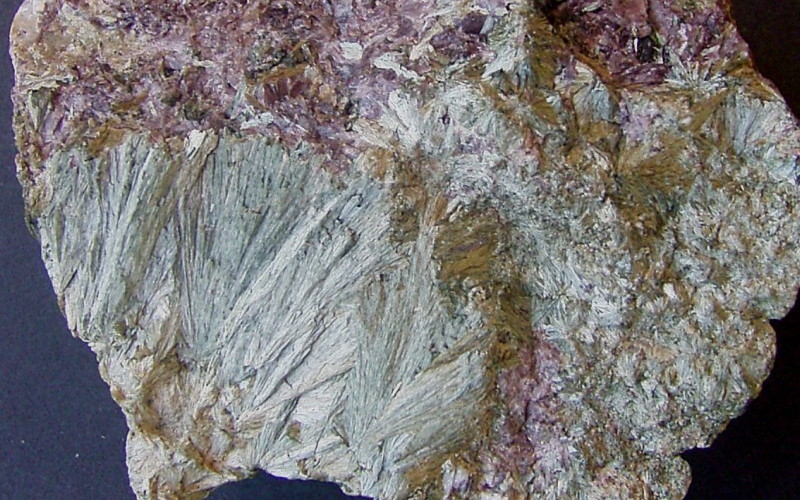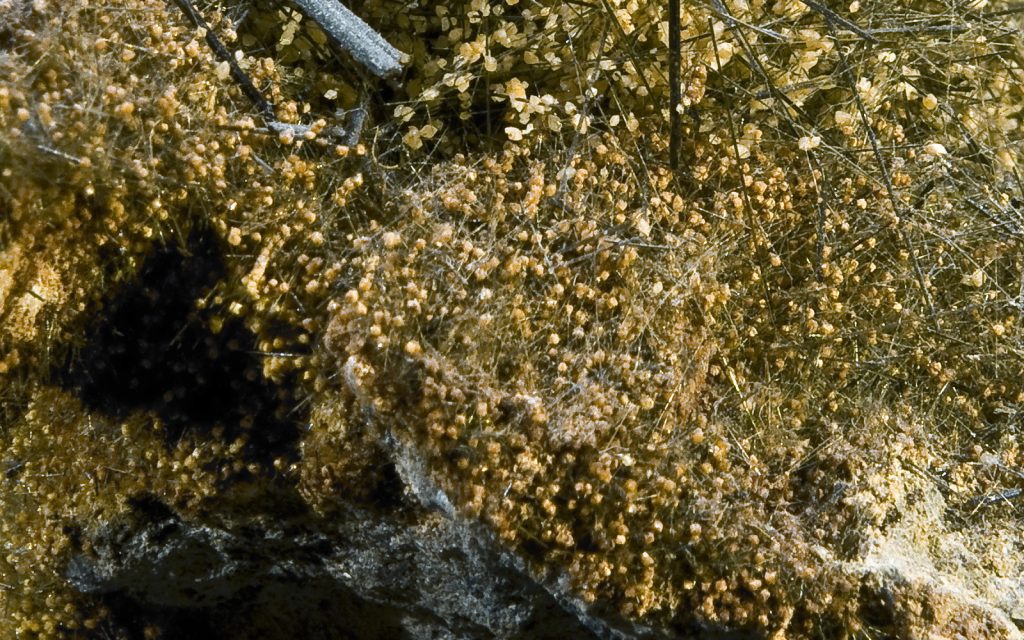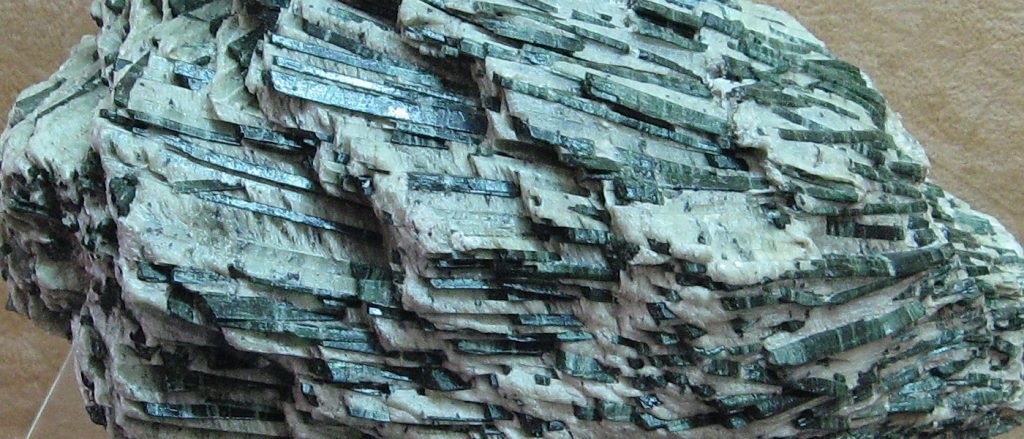Actinolite
Actinolite is a green to a grayish-green mineral that is relatively rare in nature. It is a member of the amphibole group of minerals, which also includes tremolite, pargasite, and anthophyllite. Actinolite typically forms as fibrous aggregates or massive crystals in metamorphic rocks.


Properties
Actinolite has the chemical formula Ca2(Mg, Fe)5Si8O22(OH)2. Magnesium and iron can substitute for each other in the crystal structure, which gives actinolite a range of colors. If iron is the dominant element, the mineral will be green; if magnesium is dominant, it will be white. It usually forms as fibrous or columnar crystals, sometimes in radiating groups. It has a Mohs hardness of 5.5 to 6 and a specific gravity of 2.6 to 3. It is translucent with a poor cleavage and two directions of good parting. Actinolite is monoclinic, with tabular to prismatic crystals. Actinolite is found as a metamorphic mineral in regionally metamorphosed rocks, especially in contact metamorphosed rocks and low-grade metamorphic schists. It is an important rock-forming mineral in hydrothermal veins and in low temperature metamorphic rocks.
Actinolite is not used commercially, but it is sometimes collected as a specimen by mineral enthusiasts. It can also be found in jewelry, although it is not a particularly popular gemstone. Actinolite is named for its chemical composition, which includes the element actinium. The mineral was first described in 1814 by German chemist Martin Heinrich Klaproth. The name „actinolite” comes from the Greek word „aktinos„, meaning „ray„. This is in reference to the ray-like patterns that are often seen in actinolite specimens, because of its fibrous habit. The most common color of actinolite is green, but it can also be white, gray, yellow, brown, or black.
Use
Actinolite has been used for centuries as a gemstone and ornamental stone. It is still popular today, especially in jewelry. Actinolite is also used in industry, particularly in the production of ceramic products.


The most important use of actinolite is as a metamorphic rock. It is a member of the zeolite group and is found in metamorphosed clay deposits. It is also a constituent of some igneous rocks, such as those containing amphiboles. Actinolite is used as an ornamental stone and as a gemstone.
Actinolite is an important ore of iron and a source of asbestos. It has been used for a variety of purposes, including jewelry, carvings, and as a decorative stone. It is also used in the manufacturing of glass and ceramic products. Actinolite is classified as a carcinogen and exposure to it can cause lung cancer. Asbestos fibers are also a health hazard, and should not be inhaled.
Actinolite crystals are treasured for their beauty and durability, but they also have a fascinating history. These beautiful green stones have been used for centuries in everything from jewelry to sculptures. In fact, some of the most famous sculptures in the world, such as the Venus de Milo and the Winged Victory of Samothrace, are carved from actinolite.
Actinolite can be found in a few different places around the world, including Canada, the United States, and Europe. In the United States, it is most commonly found in the state of Vermont. The actinolite mines are located in the United States, Canada, Mexico, and South America. The largest deposits are found in California, Idaho, Montana, Nevada, and Utah. Actinolite is a silicate mineral that is typically green or gray in color. It is used in a variety of applications including gemstone jewelry, ornamental carvings, and as a source of asbestos.
In the early 1900s, a large deposit of actinolite was discovered in Quebec, Canada. This deposit, known as Thetford Mines, has been mined continuously since 1903 and is currently the largest source of actinolite in the world. Other notable deposits include those in New York State, USA; Minas Gerais, Brazil; and Zhejiang Province, China.


Actinolite is most commonly used as a fibrous material in asbestos-cement products and insulation. It can also be used as a pigment in paint, plastic, and rubber. Asbestos-containing actinolite products were once widely used, but have now been banned in many countries due to health concerns associated with asbestos exposure.
Despite the health risks, some uses of actinolite continue today. For example, it is still used as a decorative material in jewelry and carved objects. It is also used in the production of certain types of ceramic products. When used in these ways, actinolite typically does not pose a health risk because it is not readily inhaled.
Actinolite has also been used in the production of gemstone jewelry. It is often used as a substitute for jade or other green stones. Actinolite is typically found in metamorphic rocks. It can also be found in some igneous rocks.
It is commonly used in the manufacture of insulation and fireproofing materials. Exposure to actinolite fibers can cause serious health problems, including mesothelioma, a rare and aggressive cancer. The risk of developing mesothelioma increases with the amount of exposure to actinolite fibers.
If you work with or around products containing actinolite, it is important to take precautions to avoid inhaling the fibers. If you think you may have been exposed to actinolite, talk to your doctor about getting tested for mesothelioma. Early detection is critical for treatment and survival.
There is no safe level of exposure to asbestos, and actinolite should be handled with caution. If you suspect that you have been exposed to actinolite fibers, talk to your doctor immediately. Early detection and treatment of mesothelioma can improve your chances of survival.
The increased demand for actinolite-based products has also led to the development of new applications for actinolite. For example, recent advancements in nanotechnology have made it possible to create nanofibers from actinolite. These nanofibers are extremely strong and lightweight, making them ideal for use in a variety of industries, such as the aerospace and automotive industries.
The global actinolite market is expected to continue growing in the coming years. This growth will be driven by the continued development of new applications for actinolite and the increasing demand for actinolite-based products.
See also: Amber stone properties
